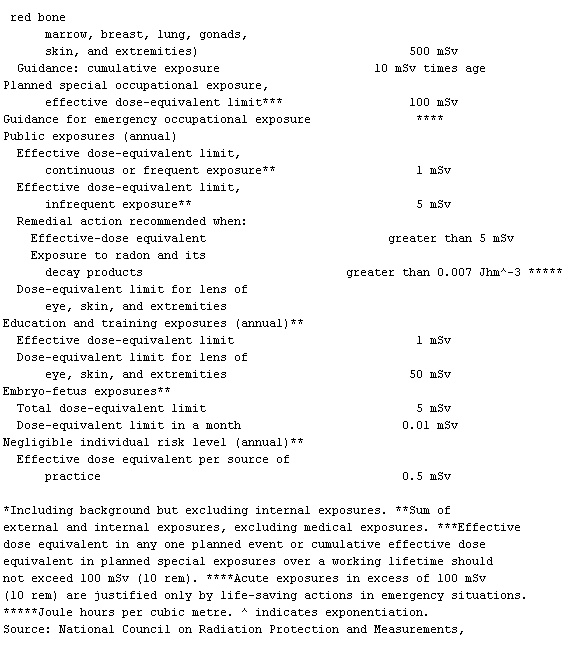- Recommended Exposure Limits*, Table
-
▪ Tabletype of exposure maximum permissibledoseEffective dose-equivalent limit(stochastic effects) 50 mSvDose-equivalent limits for tissuesand organs (non-stochastic effects)Lens of eye 150 mSvAll others (
 e.g., red bone marrow, breast, lung, gonads,skin, and extremities) 500 mSvGuidance: cumulative exposure 10 mSv times agePlanned special occupational exposure,effective dose-equivalent limit*** 100 mSvGuidance for emergency occupational exposure ****Effective dose-equivalent limit,continuous or frequent exposure** 1 mSvEffective dose-equivalent limit,infrequent exposure** 5 mSvRemedial action recommended when:Effective-dose equivalent greater than 5 mSvExposure to radon and itsdecay products greater than 0.007 Jhm^-3 *****Dose-equivalent limit for lens ofeye, skin, and extremitiesEffective dose-equivalent limit 1 mSvDose-equivalent limit for lens ofeye, skin, and extremities 50 mSvEmbryo-fetus exposures**Total dose-equivalent limit 5 mSvDose-equivalent limit in a month 0.01 mSvEffective dose equivalent per source ofpractice 0.5 mSv*Including background but excluding internal exposures. **Sum ofexternal and internal exposures, excluding medical exposures. ***Effectivedose equivalent in any one planned event or cumulative effective doseequivalent in planned special exposures over a working lifetime shouldnot exceed 100 mSv (10 rem). ****Acute exposures in excess of 100 mSv(10 rem) are justified only by life-saving actions in emergency situations.*****Joule hours per cubic metre. ^ indicates exponentiation.Source: National Council on Radiation Protection and Measurements,
e.g., red bone marrow, breast, lung, gonads,skin, and extremities) 500 mSvGuidance: cumulative exposure 10 mSv times agePlanned special occupational exposure,effective dose-equivalent limit*** 100 mSvGuidance for emergency occupational exposure ****Effective dose-equivalent limit,continuous or frequent exposure** 1 mSvEffective dose-equivalent limit,infrequent exposure** 5 mSvRemedial action recommended when:Effective-dose equivalent greater than 5 mSvExposure to radon and itsdecay products greater than 0.007 Jhm^-3 *****Dose-equivalent limit for lens ofeye, skin, and extremitiesEffective dose-equivalent limit 1 mSvDose-equivalent limit for lens ofeye, skin, and extremities 50 mSvEmbryo-fetus exposures**Total dose-equivalent limit 5 mSvDose-equivalent limit in a month 0.01 mSvEffective dose equivalent per source ofpractice 0.5 mSv*Including background but excluding internal exposures. **Sum ofexternal and internal exposures, excluding medical exposures. ***Effectivedose equivalent in any one planned event or cumulative effective doseequivalent in planned special exposures over a working lifetime shouldnot exceed 100 mSv (10 rem). ****Acute exposures in excess of 100 mSv(10 rem) are justified only by life-saving actions in emergency situations.*****Joule hours per cubic metre. ^ indicates exponentiation.Source: National Council on Radiation Protection and Measurements, Ionizing Radiation Exposure of the Population of the United States (1987).
Ionizing Radiation Exposure of the Population of the United States (1987). * * *
Universalium. 2010.
